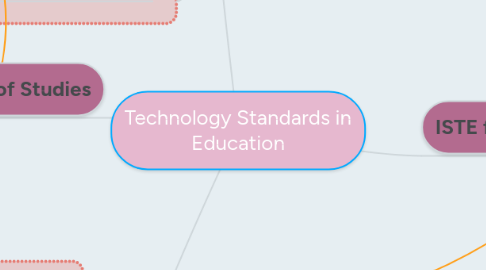
1. ISTE for Students
1.1. Empowered Learner
1.1.1. Students customize their learning environment in order to put forth initiative in setting and achieving learning goals
1.2. Digital Citizen
1.2.1. Interact in safe, informative and ethical behaviour when using technology
1.3. Innovative Designer
1.3.1. Solve problems efficiently by using tools to design a solution
1.4. Creative Communicator
1.4.1. Create original, individual content or responsibly collaborate or repurpose resources
1.5. Global Collaborator
1.5.1. Enhance learning through group work, locally and globally
2. Learning and Technology Policy Framework
2.1. Student-Centred Learning
2.1.1. Using technology to enhance student focused, individualized, authentic learning
2.2. Research and Innovation
2.2.1. Educators must participate, share, review and apply research based practice to advance classroom experiences
2.3. Professional Learning
2.3.1. Educators take previous knowledge to develop, sustain and apply their skills to using new technology
2.4. Leadership
2.4.1. Administration must govern policy to support innovation and solid foundations in support of technology in student centred learning
2.5. Access, Infrastructure and Digital Learning Environments
2.5.1. Students, teachers, and admin must have access to appropriate learning environments
3. ICT Program of Studies
3.1. Digital Citizenship
3.1.1. Moral and ethical use of technology
3.2. Productive Learner
3.2.1. Knowledge and skills required to use a variety of tools and techniques to solve problems
3.3. Problem Solver
3.3.1. Communicating, inquiring, decision making and problem solving are about the ability to use a variety of processes to critically assess information, solve problems, and communicate
3.4. Application to Real Life
3.4.1. Projects, scenarios and technology is best learnt when real life situations are replicated
3.5. Effective Communication
3.5.1. Determine which processes, resources and models to use and when to apply the variety of information
4. ISTE for Educators
4.1. Inspire Student Creativity
4.1.1. Promote student advancement, creativity, and use of technology through online forums and in person interactions
4.2. Integrate Digital Age Learning Experiences
4.2.1. Incorporate and combine digital resources to promote students to pursue individual interests
4.3. Embody Digital Age Learning
4.3.1. Exhibit knowledge of technology systems and transfer fluency to new situations
4.4. Promote Digital Responsibility
4.4.1. Demonstrate legal and ethical behaviour in regards to digital information and technology
4.5. Model Lifelong Learning
4.5.1. Participate in learning communities and demonstrate technology infusion in your classroom
